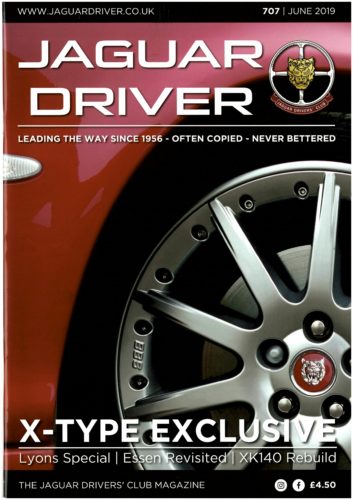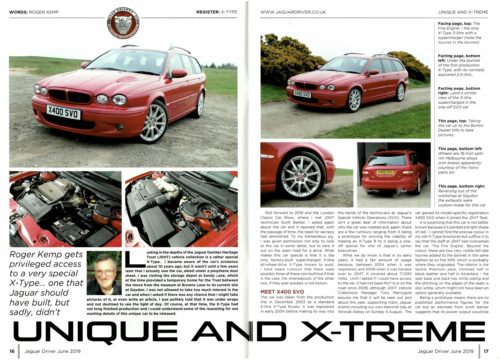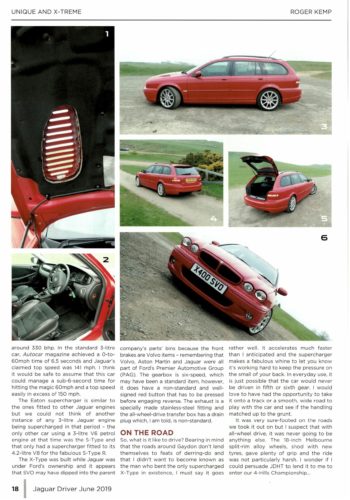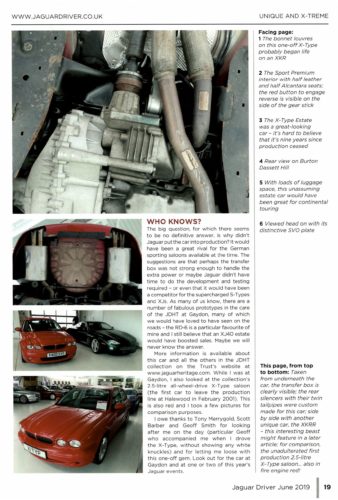UNIQUE AND X-TREME – Jaguar X-Type – Supercharged Estate – X400 SVO
Reproduced with permission of Jaguar Driver magazine (June 2019)

Jaguar Driver
June 2019
Roger Kemp gets privileged access to a very special X-Type… one that Jaguar should have built, but sadly, didn’t.
Lurking in the depths of the Jaguar Daimler Heritage Trust (JDHT) vehicle collection is a rather special X-Type. I became aware of the car’s existence about 10 years ago, but it wasn’t until a few years later that I actually saw the car, albeit under a polythene dust sheet. I was visiting the storage depot at Sandy Lane [Coventry], which at the time provided a temporary home for the Trust between the move from the museum at Browns Lane to its current site at Gaydon. I was not allowed to take too much interest in the car and when I asked if there was any chance that I might take pictures of it, or even write an article, I was politely told that it was under wraps and not destined to see the light of day. Of course, at that time, the X-Type had not long finished production and I could understand some of the reasoning for not wanting details of this unique car to be released.
Roll forward to 2019 and the London Classic Car Show, where I met JDHT technician Scott Barber. I asked him again about the car and it seemed that, with the passage of time, the need for secrecy had diminished. To my tremendous joy, I was given permission not only to look at the car in some detail, but to take it out on the open road for a drive. What makes this car special is that it is the only factory-built supercharged 3-litre all-wheel-drive X-Type known to exist. I have heard rumours that there were possibly three of these cars built but if that is the case, the whereabouts of the other two, if they ever existed, is not known.
MEET X400 SVO

Jaguar Driver – June 2019
Unique and X-Treme
X400 SVO Pages 16-17
The car was taken from the production line in December 2003 as a standard 3 litre X-Type estate. It was registered in early 2004 and then made its way into the hands of the technicians at Jaguar’s Special Vehicle Operations (SVO).
[Since this article was published we (JDHT) have now found out that this car wasn’t built at SVO but was developed as a ‘Skunk’ project at the Halewood plant by a group led by Paul Freeman at the request of the company chief designer Dave Mitchell. It did start with a standard production car and a couple of test supercharged engines from Whitley. The initial challenge was to make the engine and supercharger fit without changing the body structure so much that it needed to be crash tested separately.]
There isn’t a great deal of information about why the car was created and again there are a few rumours ranging from it being a prototype for proving the viability of making an X-Type R to it being a one-off special for one of Jaguar’s senior executives.
What we do know is that in its early years it had a fair amount of usage as between 2004 when it was registered and 2008 when it was handed over to JDHT it covered about 17,000 miles. Until I asked if I could have access to the car it had not been MOT’d or on the road since 2008 although JDHT Vehicle Collections Manager, Tony Merrygold, assures me that it will be seen out and about this year [2019] supporting many Jaguar events including our own National Day at Wroxall Abbey on Sunday 4th August. The car gained its model specific registration, X400 SVO, when it joined the JDHT fleet.

Jaguar Driver – June 2019
Unique and X-Treme
X400 SVO Page 18
It is surprising that this car is not better known as it is painted a bright shade of red – I cannot find the precise colour in my old X-Type brochures but suffice it to say that the staff at JDHT had nicknamed the car the Fire Engine. Beyond the colour there are two very visible tell-tale louvres added to the bonnet in the same fashion as the XKR which is probably where they originated. The interior is the “Sports Premium” pack trimmed half in black leather and half in Alcantara – the seat base and back has white piping and the stitching on the edge of the seats is also white which may not have been an option generally available.
Being a prototype means there are no published performance figures for the car but an estimate from Scott Barber suggests that its power output would be around 330 bhp. In the standard 3 litre car Autocar magazine achieved a 0 to 60 time of 6.5 seconds and Jaguar’s claimed top speed was 141 mph. I think it would be safe to assume this car could manage a sub 6 second time for hitting the magic 60 mph and a top speed easily in excess of 150 mph.
The Eaton supercharger is similar to the ones fitted to other Jaguar engines but, we could not think of another instance of any other 3 litre Jaguar engine being supercharged in that period, the only other car using a 3 litre V6 petrol engine at that time was the S-Type and that only had a supercharger fitted to its 4.2 litre V8 for the fabulous S-Type R.
The X-Type was built while Jaguar was under Ford’s ownership and it appears that SVO may have dipped into the parent company’s parts’ bins as the front brakes are Volvo items – always remembering that Volvo, Aston Martin and Jaguar were all part of Ford’s Premier Automotive Group (PAG). The gearbox is 6-speed which may have been a standard item but it does have a non-standard well signed red button that has to be pressed before engaging reverse. The exhaust is a specially made stainless steel fitting and the all-wheel drive transfer box has a drain plug which I am told is non-standard.
ON THE ROAD
So, what is it like to drive? Always bearing in mind that the roads around Gaydon do not lend themselves to feats of derring-do and also that I did not want to become known as the man who bent the only supercharged X-Type then even taking those restrictions into account I must say it does go rather well. It accelerates much faster than I anticipated and the supercharger makes a fabulous whine to let you know it is working hard to keep the pressure on the small of your back. In everyday use it is just possible that the car would never be driven in 5th or 6th gears. I would love to have had the opportunity to take it on to a track or a smooth wide road to play with the car to see if the handling matched up to the grunt.
It was very sure footed on the roads we took it on but I suspect with all wheel drive it was never going to be anything else. The 18 inch Melbourne split-rim alloy wheels shod with new tyres gave plenty of grip and the ride was not particularly harsh. I wonder if I could persuade JDHT to lend it to me to enter into our 4-Hills Championship…
WHO KNOWS?

Jaguar Driver – June 2019
Unique and X-Treme
X400 SVO Page 19
The big question for which there seems to be no definitive answer is why didn’t Jaguar put the car into production? It would have been a great rival for the German sporting saloons available at the time. The suggestions are that perhaps the transfer box was not strong enough to handle the extra power or maybe Jaguar didn’t have time to do the development and testing required or even that it would have been a competitor for the supercharged S-Types and XJs. As many of us know there are a number of fabulous prototypes in the care of the JDHT at Gaydon many of which we would have loved to see on the roads – The RD-6 is a particular favourite of mine and I still believe that an XJ40 estate would have boosted sales. Maybe we will never know the answers.
More information is available about this car and all the other cars in the JDHT collection on the JDHT website www.jaguarheritage.com . Whilst I was at Gaydon I also looked at the 2.5 litre all wheel drive X-Type saloon that is in the collection (the first car to leave the production at Halewood in February 2001) which is also red and took a few pictures for comparison purposes.
I owe thanks to Tony Merrygold, Scott Barber and Geoff Smith for looking after me on the day (particular Geoff who accompanied me when I drove without showing any white knuckles) and for letting me loose with this one-off gem. Do look out for the car at Gaydon and at one or two of this year’s Jaguar events.
Words and Photography: Roger Kemp